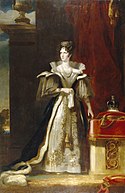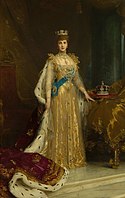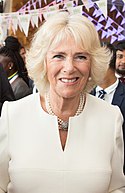Britiske dronninger og prinsgemaler

De britiske dronninger og prinsgemaler dækker ægtefæller til de regerende konger eller dronninger af Det Forenede Kongerige af Storbritannien. Gemalerne i det britiske monarki og dets forgængere har ingen forfatningsmæssig status eller magt, men mange havde betydelig indflydelse på deres ægtefæller. Nogle kongelige gemaler, såsom den seneste prinsgemal Prins Philip, hertug af Edinburgh, har også medvirket til at forbedre monarkiets image ved at blive berømtheder i deres eget navn. Prins Philip er den længst siddende og ældste gemal nogensinde. Hans svigermor, Dronning Elizabeth, der døde i en alder af 101 år, levede længere, men da hun døde var hun ikke gemal, da hendes mand Kong Georg 6. var død 50 år tidligere.
Historie
Siden foreningen af England og Skotland i 1707 har der været ti gemaler til den britiske monark. Dronninger mellem 1727 og 1814 var også kurfyrstinder af Hannover, da deres mænd alle havde titlen som kurfyrste af Hannover. Mellem 1814 og 1837 havde dronninger også titel af dronning af Hannover, da deres mænd var konger af Hannover. Den personlige union med Det Forenede Kongerige sluttede i 1837 ved Dronning Victorias tronbestigelse, fordi arvelovene i Hannover ikke tillod en kvinde at arve tronen, hvis der var en levende mandlig arving (i Storbritannien havde en mand kun forrang over sin egne søstre, indtil ændringen af den britiske tronfølgelov i 2013, som fjernede mandlige førstefødselsret). I Den preussisk-østrigske krig i 1866 blev Hannover annekteret af Preussen og blev inkorporeret som Provinsen Hannover.
Undtagelser
Ikke alle hustruer til monarker er blevet gemaler, da de kan være døde, blevet skilt, fået erklæret deres ægteskab ugyldigt, inden deres mænd besteg tronen eller blev gift efter abdiceringer. Sådanne tilfælde inkluderer:
- Sophie Dorothea af Celle, hustru til Georg 1. af Storbritannien (som arving for Kurfyrstendømmet Hannover ), gift den 22. november 1682, skilt den 28. december 1694, døde den 13. november 1726.
- Maria Anne Fitzherbert, hustru til Georg 4. af Storbritannien (som Prins af Wales), gift 1785, ægteskab erklæret ugyldigt, døde i 1837.
- Wallis Warfield Simpson, hustru til Edvard 8. (som hertug af Windsor) og derfor ikke hustru til en regerende konge, gift 3. juni 1937, døde den 24. april 1986.
Et usædvanlig tilfælde var Karoline af Braunschweig, der var blevet separeret fra sin mand Georg 4. forud for hans tronbestigelse, og selvom hun i realiteten var hans gemal, blev hun holdt væk fra hoffet og blev med magt afskåret fra at deltage i George 4.'s kroning og selv blive kronet. Dette medførte offentlig forargelse.
Alle kvindelige gemaler har haft ret til at være og blevet tituleret som dronninger. Imidlertid er ingen af de tre britiske mandlige gemaler, der har været siden 1707, blevet betragtet som kongegemaler:
- Prins Jørgen af Danmark, Dronning Annes mand modtog heller aldrig den officielle titel som Prinsgemal, men blev ophøjet til den engelske adel som hertugen af Cumberland i 1689, flere år inden hans hustrus tronbestigelse i 1702.
- Prins Albert af Sachsen-Coburg og Gotha, Dronning Victorias mand, tog ikke en engelsk hertugtitel, men blev tildelt titlen Prinsgemal (Prince Consort) som en særlig titel i 1857. Indtil da havde ingen mandlige gemal i hverken Storbritannien eller dets forgængere officielt haft denne titel. Først blev det foreslået, at han kunne blive kongegemal, men dette blev afvist af regeringen.
- Prins Philip af Grækenland og Danmark, dronning Elizabeth 2.'s mand, der allerede blev ophøjet til den britiske adel som hertug af Edinburgh i 1947, blev gjort til Prins af Storbritannien i 1957. Han blev ikke tituleret som prinsgemal.
Siden 1707 har kun Georg 1. og Edvard 8. været ugifte gennem hele deres regeringsperioder.
Dronninger og prinsgemaler i Kongeriget Storbritannien (1707-1801) og Det Forenede Kongerige af Storbritannien (1801 - nuværende)
| Billede | Våbenskjold | Navn | Forældre | Født | Ægteskab | Blev prinsgemal | Kroning | Ophør som prinsgemal | Død | Hvilested | Ægtefælle |
|---|---|---|---|---|---|---|---|---|---|---|---|
 |  | Prins Jørgen af Danmark og Norge | Far, Frederik 3. af Danmark og Norge Mor, Sophie Amalie af Braunschweig-Lüneburg | 2. april 1653 | 28. juli 1683 | 1. maj 1707 Oprettelse af Kongeriget Storbritannien | Ikke kronet | 28. oktober 1708 55 år | Westminster Abbey | Anne | |
| Billede | Våbenskjold | Navn | Forældre | Født | Ægteskab | Blev dronning/prinsgemal | Kroning | Ophør som dronning/prinsgemal | Død | Hvilested | Ægtefælle |
|---|---|---|---|---|---|---|---|---|---|---|---|
 |  | Karoline af Brandenburg-Ansbach | Far, Johan Frederik, Margrave af Brandenburg-Ansbach Mor, Eleonora Erdmuthe af Saxe-Eisenach | 1. marts 1683 | 22. august 1705 | 11. juni 1727 Mands tronbestigelse | 11. oktober 1727 | 20. november 1737 54 år | Westminster Abbey | Georg 2. | |
 |  | Charlotte af Mecklenburg-Strelitz | Far, Karl Ludvig Frederik af Mecklenburg Mor, Elisabeth Albertine af Sachen-Hildburghausen | 19. maj 1744 | 8. september 1761 | 22. september 1761 | 17. november 1818 74 år | St George's Chapel, Windsor Castle | Georg 3. | ||
 | 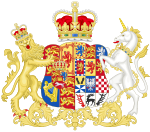 | Karoline af Braunschweig-Wolfenbüttel | Far, Karl Vilhelm Ferdinand, hertug af Branschweig-Wolfenbüttel Mor, Augusta af Storbritannien | 17. maj 1768 | 8. april 1795 | 29. januar 1820 Mands tronbestigelse | Ikke kronet | 7. august 1821 53 år | Katedralen i Braunschweig | Georg 4. | |
 |  | Adelaide af Sachen-Meiningen | Far, Georg 1., hertug af Sachen-Meiningen Mor, Louise Eleanore af Hohenlohe-Langenburg | 13. august 1792 | 13. juli 1818 | 26. juni 1830 Mands tronbestigelse | 8. september 1831 | 20. juni 1837 Mands død | 2. december 1849 56 år | St George's Chapel, Windsor Castle | Vilhelm 4. |
 |  | Albert af Sachen-Coburg og Gotha | Far, Ernst 1., hertug af Saxe-Coburg og Gotha Mor, Louise af Sachen-Gotha-Altenburg | 26. august 1819 | 10. februar 1840 | Ikke kronet | 14. december 1861 42 år | St George's Chapel, Windsor Castle derefter Frogmore Mausoleum | Victoria | ||
Huset Sachsen-Coburg og Gotha, omdøbt til Huset Windsor i 1917
| Billede | Våbenskjold | Navn | Forældre | Født | Ægteskab | Blev dronning/prinsgemal | Kroning | Ophør som dronning/pringsgemal | Død | Hvilested | Ægtefælle |
|---|---|---|---|---|---|---|---|---|---|---|---|
 |  | Alexandra af Danmark | Far, Christian 9. af Danmark Mor, Louise af Hessen-Kassel | 1. december 1844 | 10. marts 1863 | 22. januar 1901 Mands tronbestigelse | 9. august 1902 | 6. maj 1910 Mands død | 20. november 1925 80 år | St George's Chapel, Windsor Castle | Edvard 7. |
 | 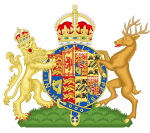 | Mary af Teck | Far, Frans, hertug af Teck Mor, Mary Adelaide af Cambridge | 26. maj 1867 | 6. juli 1893 | 6. maj 1910 Mands tronbestigelse | 22. juni 1911 | 20. januar 1936 Mands død | 24. marts 1953 85 år | St George's Chapel, Windsor Castle | Georg 5. |
 |  | Lady Elizabeth Bowes-Lyon | Far, Claude Bowes-Lyon, 14. jarl af Strathmore og Kinghorne Mor, Cecilia Cavendish-Bentinck | 4. august 1900 | 26. april 1923 | 11. december 1936 Mands tronbestigelse | 12. maj 1937 | 6. februar 1952 Mands død | 30. marts 2002 101 år | St George's Chapel, Windsor Castle | Georg 6. |
 |  | Philip af Grækenland og Danmark ændret i 1947 til Philip Mountbatten | Far, Andreas af Grækenland Mor, Alice af Battenberg | 10. juni 1921 | 20. november 1947 | 6. februar 1952 Hustrus tronbestigelse | Ikke kronet | 9. april 2021 99 år | St George's Chapel, Windsor Castle | Elizabeth 2. | |
 |  | Camilla Shand | Far, Bruce Shand Mor, Rosalind Cubitt | 17. juli 1947 | 9. april 2005 | 8. september 2022 Mands tronbestigelse | 6. maj 2023 | Nuværende | Charles 3. | ||
Referencer
Eksterne links
Medier brugt på denne side
Forfatter/Opretter: Sodacan, Licens: CC BY-SA 3.0
Personligt våbenskjold for Prins Jørgen af Danmark og Norge, Hertug af Cumberland. Prinsgemal til Dronning Anne af Storbritannien. Moderne tegning.
Forfatter/Opretter: Sodacan, Licens: CC BY-SA 3.0
Coat of arms of Queen Adelaide of Saxe-Meiningen, Consort of King William IV of the United Kingdom.
Prince George of Denmark and Norway, husband of the Queen of England, Scotland and Ireland, wearing a ducal robe with the collar of the Garter.
Forfatter/Opretter: Sodacan, Licens: CC BY-SA 4.0
Coat of arms of Queen Camilla.
| Caption from the museum's website / Gallery label |
|---|
|
Caroline of Brunswick married her first cousin, George, Prince of Wales on 8 April 1795. Later in the month the Prince told John Hoppner that the King (George III) wished for a portrait of the bride. In August 1795 Hoppner somehow offended George III and the commission was given to Gainsborough Dupont, who had kept up his uncle's studio in Schomberg House. The Princess sat to Dupont in June 1795; by March 1796 the portrait was finished, though the frame was not ready for the Royal Academy exhibition of that year and the painting was rejected as a consequence. The Princess is shown in her wedding dress wearing a miniature of her husband on her breast. |
Painted for Queen Victoria. Portrait of Prince Albert; the three chains are (from top to bottom) the collars of the orders of the Golden Fleece, Bath and Garter.
Forfatter/Opretter: Sodacan, Licens: CC BY-SA 3.0
'’’Coat of Arms of Elizabeth Angela Marguerite Bowes-Lyon, Queen consort of the United Kingdom and the British Dominions, Empress of India from 1936 – 1952’’’, (born 1900) granted in 1936 after the accession of her husband Albert, Duke of York as King George VI. The Queen continued to use the coat of arms as ‘’’Queen Elizabeth, The Queen Mother’’’ until her death in 2002.
| “ | The Royal arms, impaling, quarterly, First and Fourth, Argent, a lion rampant Azure armed and langued Gules within a double tressure flory counter-flory of the second (For Lyon); Second and Third, Ermine, three bows, strings palewise Proper (For Bowes), the whole surrounded by the Garter; for a Crest, the imperial crown Proper; for Supporters, dexter a lion rampant guardant Or, imperially crowned Proper, sinister, a lion per fess Or and Gules; in the compartment below the shield, with the Union rose, shamrock and thistle engrafted on the same stem. | ” |
- PINCHES, J.H & R.V., The Royal Heraldry of England, 1974, Heraldry Today.
Forfatter/Opretter: Sodacan, Licens: CC BY-SA 3.0
Coat of Arms of Alexandra of Denmark, Queen of the United Kingdom
Coronation portrait of Queen Mary of Teck
Forfatter/Opretter: The Big Lunch, Licens: CC BY-SA 2.0
The Commonwealth Big Lunch on April 17, 2018 was held in London as part of the Commonwealth Heads of Government Meeting.
Reproduction of a photograph of Prince Phillip, which is under my property.
Charlotte of Mecklenburg-Strelitz (1744-1818), queen of Great Britain and Ireland, in an official portrait painted shortly after her wedding
Forfatter/Opretter: Sodacan, Licens: CC BY-SA 3.0
Coat of arms of Prince Albert of Saxe-Coburg and Gotha, the Prince Consort (born 1819), consort of Queen Victoria of the United Kingdom of Great Britain and Ireland from 1840, until his death in 1861.
On his marriage to Queen Victoria in 1840, Prince Albert was granted his own personal coat of arms, which was the royal coat of arms of the United Kingdom differenced with a three-point label bearing a red cross in the centre, quartered with the arms of Saxony. The blazon is written as: "Quarterly, 1st and 4th, the Royal Arms, with overall a label of three points Argent charged on the centre with cross Gules; 2nd and 3rd, Barry of ten Or and Sable, a crown of rue in bend Vert". The Prince's peculiar arms was a "singular example of quartering differenced arms, [which] is not in accordance with the rules of Heraldry, and is in itself an heraldic contradiction." Prior to his marriage he used the arms of his father, undifferenced, following German practice.
On his stallplate as a Knight of the Garter his coat of arms is ensigned by a royal crown and shows the six crests of the House of Saxe-Coburg and Gotha; these are from left to right: 1. "A bull's head caboshed Gules armed and ringed Argent, crowned Or, the rim chequy Gules and Argent" for Mark. 2. "Out of a coronet Or, two buffalo's horns Argent, attached to the outer edge of each five branches fesswise each with three linden leaves Vert" for Thuringia. 3. "Out of a coronet Or, a pyramidal chapeau charged with the arms of Saxony ensigned by a plume of peacock's feathers Proper out of a coronet also Or" for Saxony. 4. "A bearded man in profile couped below the shoulders clothed paly Argent and Gules, the pointed coronet similarly paly terminating in a plume of three peacock's feathers" for Meissen. 5. "A demi griffin displayed Or, winged Sable, collared and langued Gules" for Jülich. 6. "Out of a coronet Or, a panache of peacock's feathers Proper" for Berg.
The supporters were the crowned lion of England and the unicorn of Scotland (as in the Royal Arms) charged on the shoulder with a label as in the arms. Albert's personal motto is the German Treu und Fest (Loyal and Sure).Forfatter/Opretter: Sodacan, Licens: CC BY-SA 3.0
Coat of Arms of Mary of Teck, Queen of the United Kingdom and Empress of India
Forfatter/Opretter: Sodacan, Licens: CC BY-SA 3.0
Coat of Arms of HRH Prince Philip, Duke of Edinburgh (born 1921, died 2021) granted in 1949 to Prince Philip of Greece and Denmark (Sir Philip Mountbatten) consort to Queen Elizabeth II of the United Kingdom of Great Britain and Northern Ireland. In 1947 the Prince was made Duke of Edinburgh, Earl of Merioneth and Baron Greenwich by King George VI. The coat of arms represents his lineage as a Prince of Greece and Denmark on his paternal side and his descent of the Mountbatten family on his maternal side.
| “ | Quarterly, First Or, semée of hearts Gules, three lions passant in pale Azure (For Denmark), Second Azure, a cross Argent (For Greece), Third Argent, two pallets Sable (For Battenberg or Mountbatten), Fourth Argent, upon a rock Proper a castle triple towered Sable, masoned Argent, windows, port, turret-caps and vanes Gules (For Edinburgh), the whole surrounded by the Garter; for a crest, upon a coronet of a son of the sovereign Proper, the royal helm Or, upon which issuant from a ducal coronet Or, a plume of five ostrich feathers alternately Sable and Argent; Mantling Or and ermine; for Supporters, dexter, a representation of Hercules girt about the loins with a lion skin, crowned with a chaplet of oak leaves, holding in the dexter hand a club Proper, sinister, a lion queue fourchée ducally crowned Or and gorged with a naval coronet Azure; Motto ’God Is My Help’. | ” |
Forfatter/Opretter: Sodacan, Licens: CC BY-SA 3.0
Coat of arms of Queen Caroline of Brandenburg-Ansbach, Consort of King George II of Great Britain.
Forfatter/Opretter: unknown, Licens:
Forfatter/Opretter: Sodacan, Licens: CC BY-SA 3.0
Coat of arms of Queen Caroline of Brunswick, Consort of King George IV of the United Kingdom.


